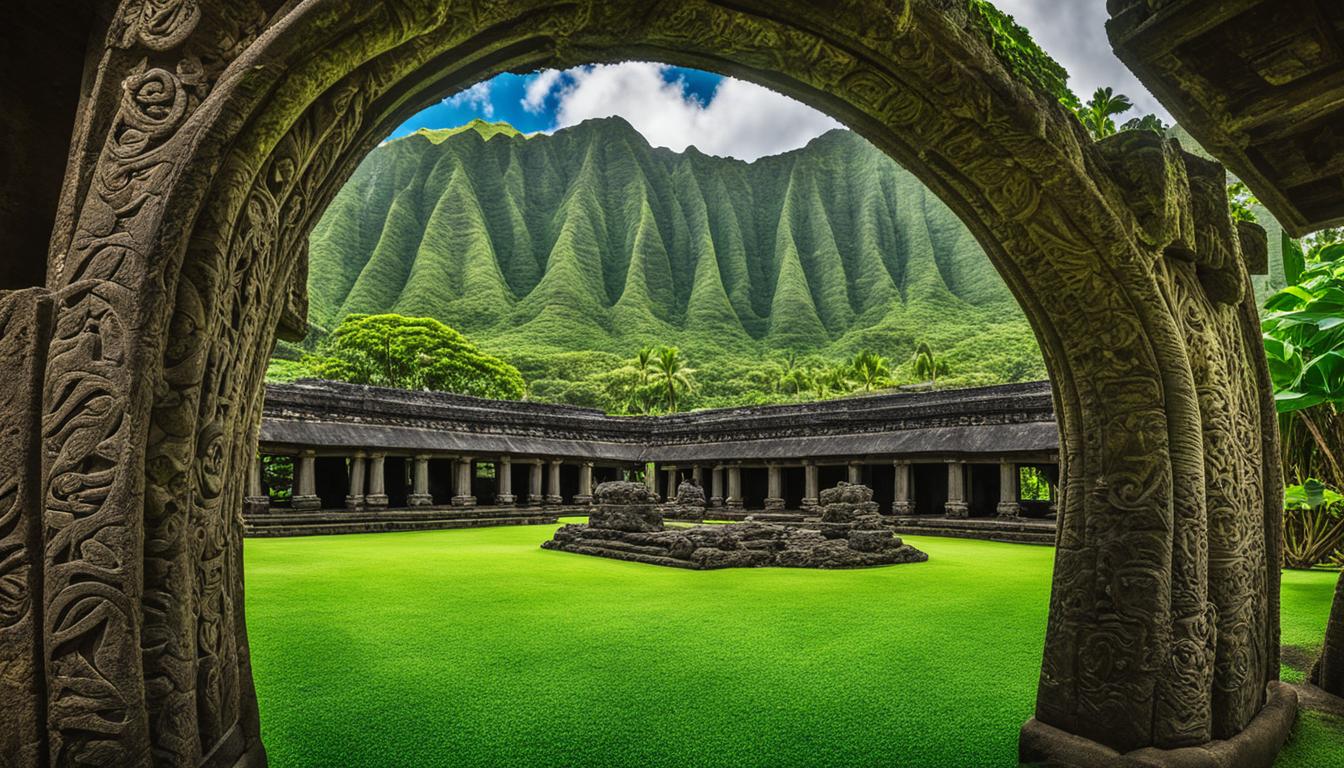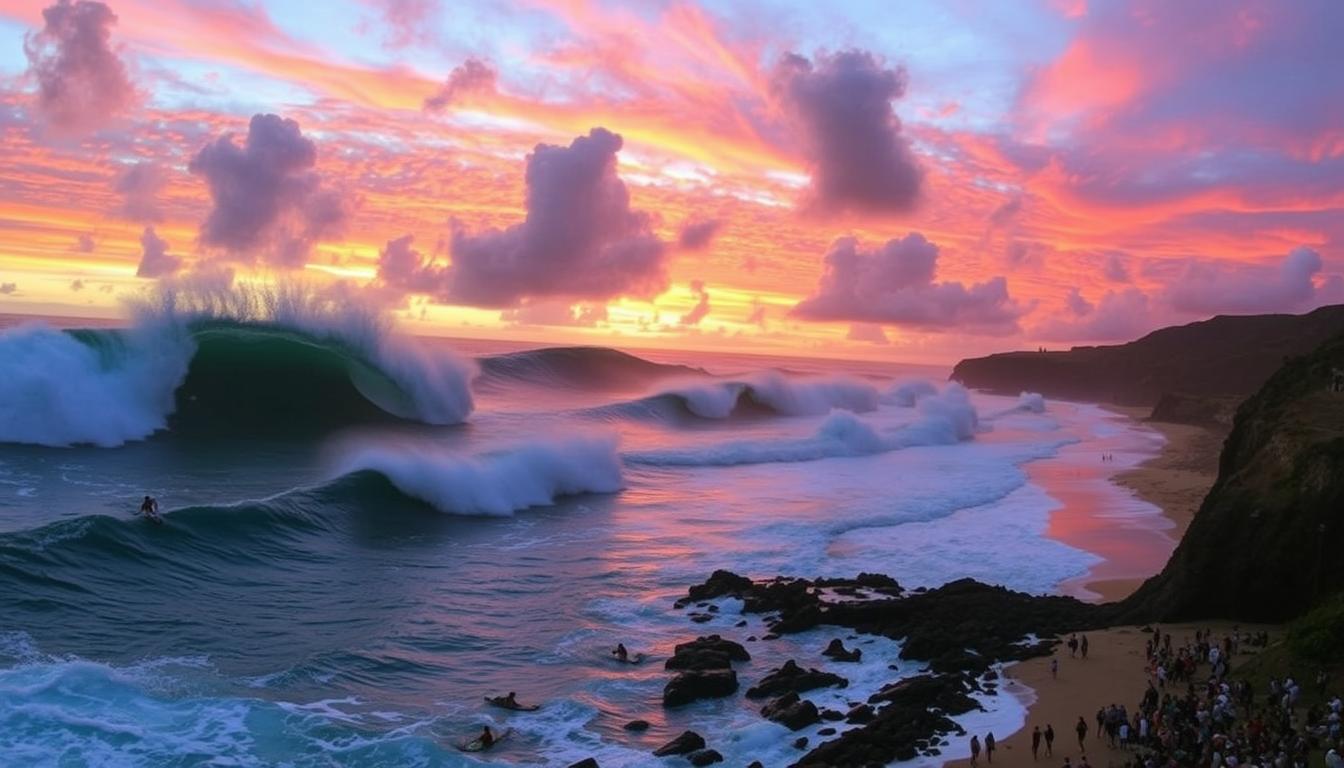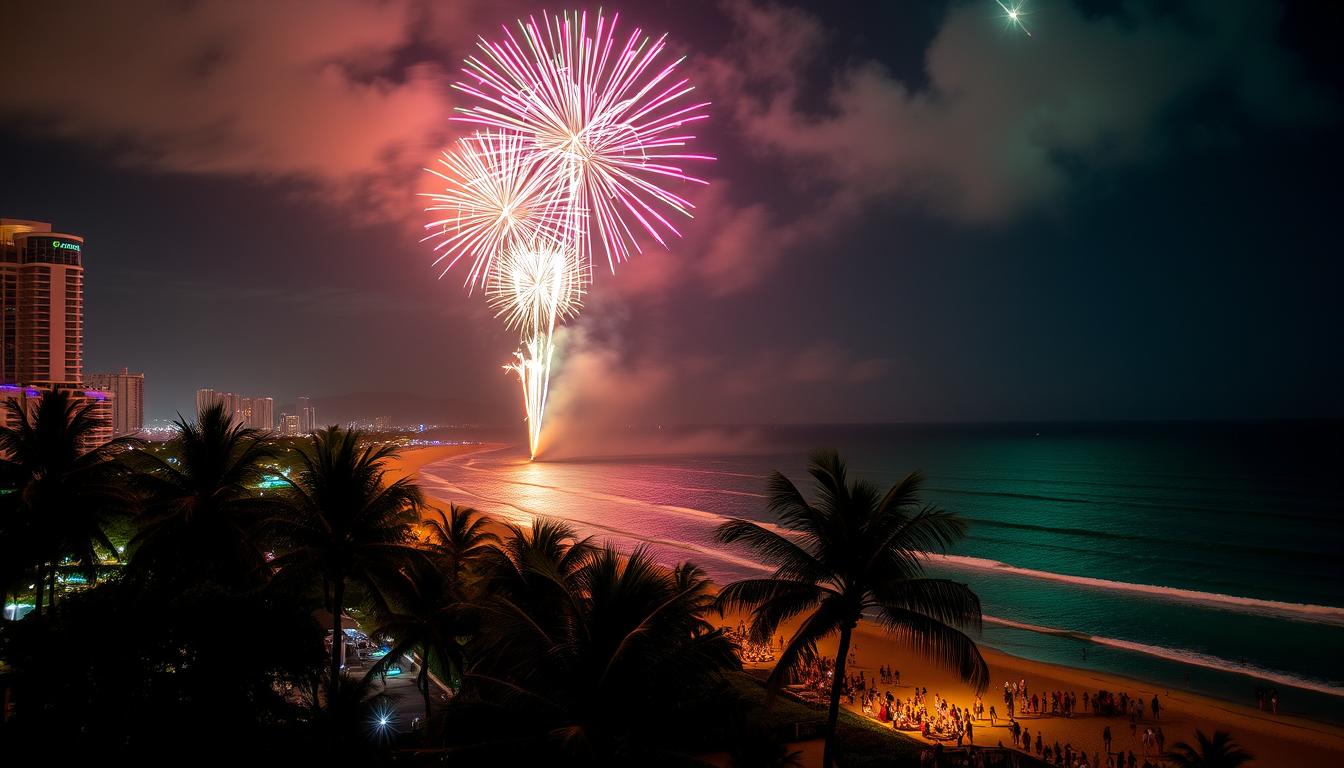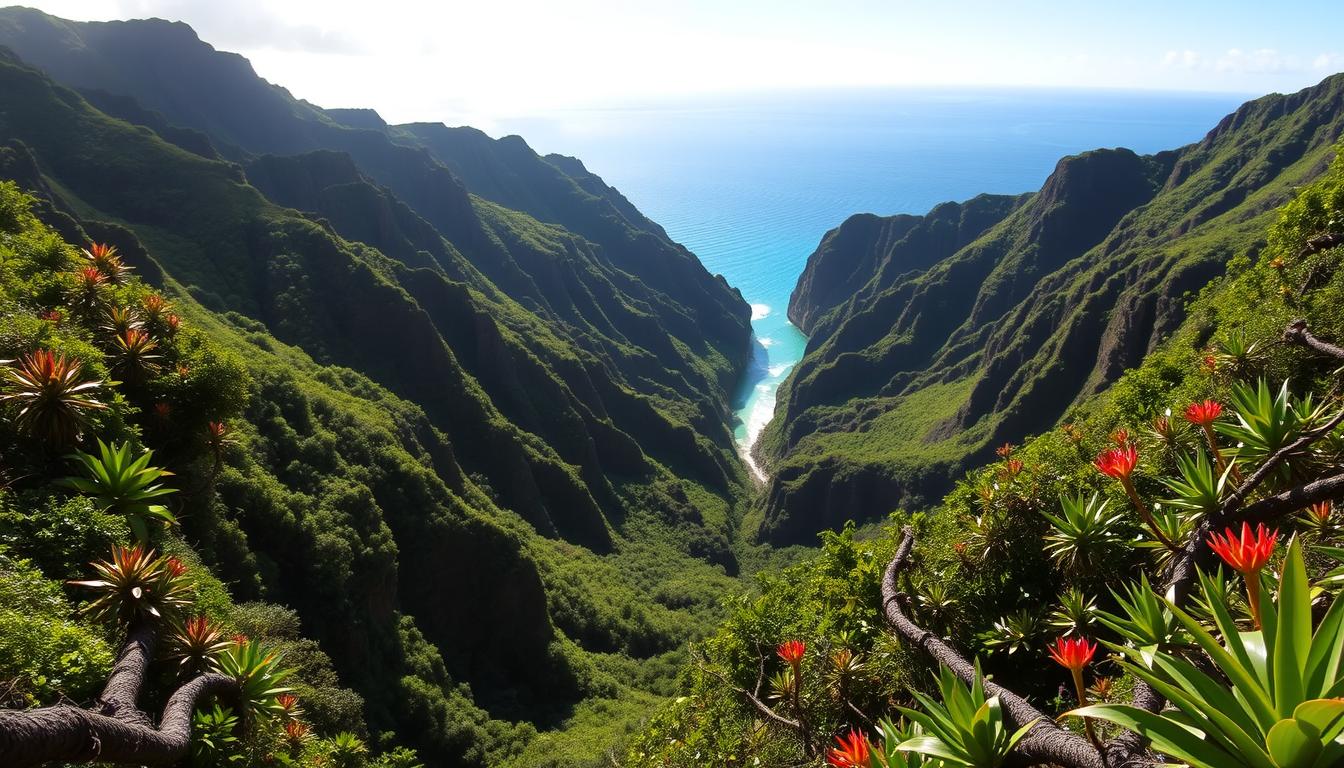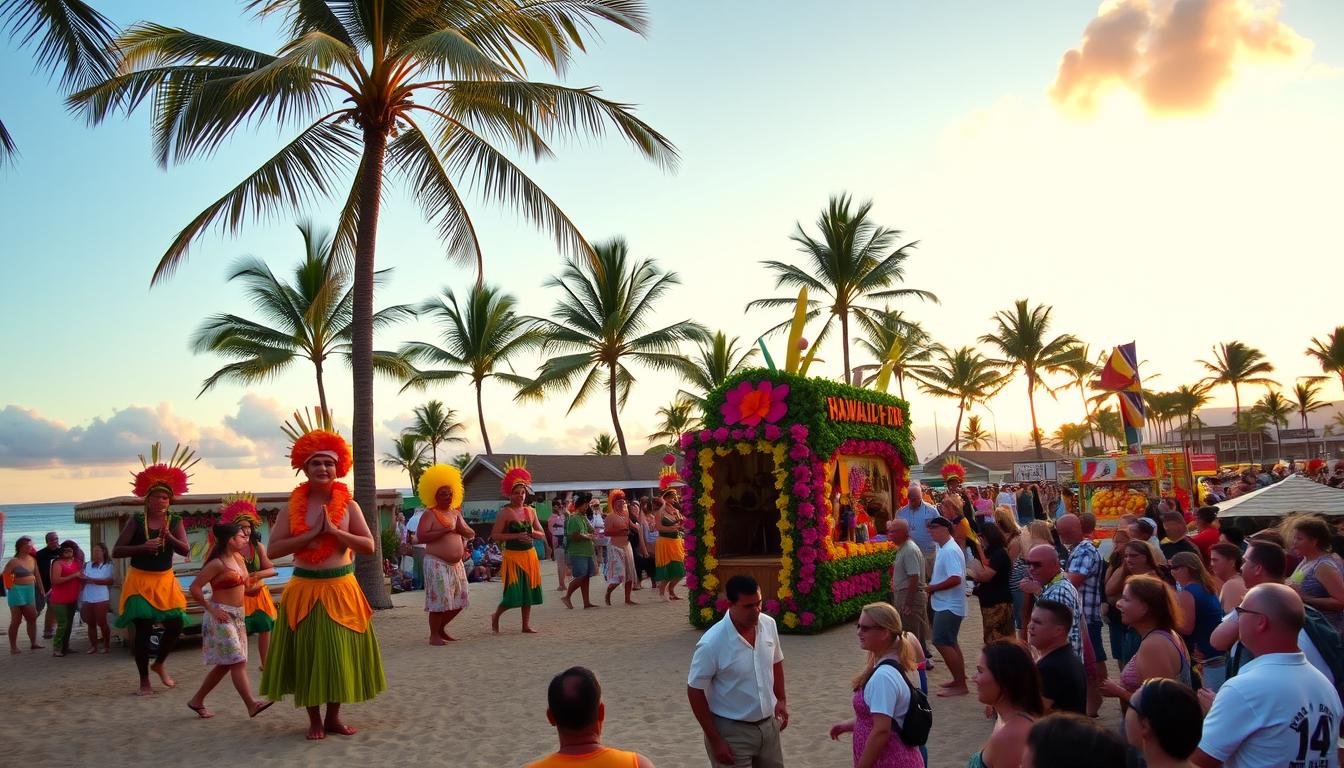Oahu is not only known for its stunning beaches and vibrant culture, but it also boasts a rich historical past that is worth exploring. From ancient Hawaiian temples to royal palaces, Oahu is filled with historical sites that offer a glimpse into the island’s fascinating history. In this article, we will take a closer look at some of the prominent historical landmarks and cultural experiences that you can discover on Oahu.
Key Takeaways:
- Oahu has a rich historical past that goes beyond its beautiful beaches and vibrant culture.
- The island is home to historical sites such as ancient Hawaiian temples and royal palaces.
- Exploring the historical landmarks of Oahu provides insights into the island’s fascinating history.
- By visiting these sites, you can discover the cultural heritage and traditions of Oahu.
- Immersing yourself in Oahu’s history allows for a deeper appreciation of the island’s heritage.
Unveiling Oahu’s Monarchical Heritage: ‘Iolani Palace
‘Iolani Palace is a significant historical landmark on Oahu that offers a deep insight into the Hawaiian Monarchy. As the spiritual and political heart of the monarchy, ‘Iolani Palace served as the official residence of the last Hawaiian monarchs until the overthrow of the monarchy in 1893. The palace’s architectural grandeur reflects the opulence and splendor of the Hawaiian royalty. Today, visitors can explore the palace through educational tours, experiencing the cultural resonance of this historical site.
The Spiritual and Political Heart of the Hawaiian Monarchy
‘Iolani Palace holds immense historical and cultural significance as it was the spiritual and political heart of the Hawaiian Monarchy. It served as the official residence of King Kalakaua and his sister, Queen Liliuokalani, the last reigning monarchs of Hawaii. The palace witnessed the significant events and decisions that shaped the destiny of the Hawaiian people.
Architectural Grandeur Steeped in Royal History
The architectural grandeur of ‘Iolani Palace is a testament to the rich history and cultural heritage of the Hawaiian royalty. The palace is a masterpiece of Hawaiian Renaissance architecture and blends Western architectural styles with distinctive Hawaiian elements. From its elegant facade to its intricate interior decor, ‘Iolani Palace showcases the opulence and craftsmanship of the monarchy.
Cultural Resonance and Educational Tours
Exploring ‘Iolani Palace allows visitors to immerse themselves in the cultural resonance of the Hawaiian Monarchy. Educational tours provide insights into the traditions, customs, and history of the Hawaiian people. Visitors can witness the majestic throne room, stroll through the beautifully landscaped grounds, and learn about the monarchy’s enduring legacy.
Retreat of Royalty: Queen Emma Summer Palace
Exploring the 19th Century Hawaiian Retreat
Queen Emma Summer Palace, also known as Hānaiakamalama, offers a unique glimpse into the 19th-century Hawaiian retreat of Queen Emma and King Kamehameha IV. This mountain home provided a respite for the royal couple during the summer months. Visitors can explore the palace and view traditional featherwork, royal artifacts, and furnishings that belonged to Queen Emma. The knowledgeable docents provide valuable insights into the history and culture surrounding the palace, while the lush gardens create a serene and tranquil atmosphere.
Traditional Featherwork and Royal Artifacts
One of the highlights of the Queen Emma Summer Palace is the display of traditional featherwork, a renowned art form in Hawaiian culture. These intricate pieces showcase the skill and craftsmanship of the Hawaiian people. Visitors can marvel at the vibrant colors and intricate designs of feather capes and helmets, which were symbols of status and power for the Hawaiian royalty. Additionally, the palace houses a remarkable collection of royal artifacts, including personal belongings and historical artifacts that provide a deeper understanding of the royal lifestyle.
Insights from Docents and Lush Gardens
Exploring the Queen Emma Summer Palace is a truly immersive experience thanks to the knowledgeable docents who share fascinating stories and historical insights. Their expertise brings the palace to life and helps visitors connect with the rich heritage of Queen Emma and King Kamehameha IV. The lush gardens surrounding the palace provide a peaceful setting for visitors to reflect and appreciate the natural beauty of the Hawaiian landscape. It’s a serene oasis that perfectly complements the historical significance of the retreat.
Historical Oahu: Bishop Museum’s Treasures
The Bishop Museum, founded in 1889, is a treasure trove of cultural and natural history artifacts from Hawai’i and Polynesia. With an extensive collection of over 24 million items, the museum offers a comprehensive look at the rich history of Oahu. From Polynesian migration to life during the Hawaiian monarchy, the Bishop Museum provides a deep understanding of Oahu’s past through its exhibits and displays.
A Hike Through History: Lēʻahi and Nu’uanu Pali State Wayside
Oahu’s natural wonders, such as the iconic Lēʻahi (Diamond Head) and Nu’uanu Pali State Wayside, have played significant roles in the island’s history. These sites hold not only breathtaking views but also fascinating stories of their impact on Oahu’s past.
Impacts of Natural Wonders on Oahu’s Past
The natural wonders of Lēʻahi and Nu’uanu Pali State Wayside have shaped the history of Oahu. These sites have witnessed significant events and have been intrinsically intertwined with the island’s development.
Lēʻahi, with its towering presence and panoramic vistas, served as a strategic lookout point for ancient Hawaiians. The views from the summit offered a clear vantage point, enabling early inhabitants to monitor the coastline and detect potential threats.
Nu’uanu Pali, revered for its dramatic cliffs and breathtaking landscape, witnessed a historic battle that changed the course of Oahu’s history. In 1795, the Battle of Nu’uanu took place here, where King Kamehameha I overcame the forces of Oahu’s ruling chief, ultimately unifying the Hawaiian Islands under his rule.
These natural wonders not only provided practical advantages but also held cultural and spiritual significance for the people of Hawaii. The majestic presence of Lēʻahi and the breathtaking beauty of Nu’uanu Pali connected ancient Hawaiians to their land and history, fostering a deep sense of identity.
Strategic Importance in Hawaiian Warfare
Lēʻahi and Nu’uanu Pali played pivotal roles in Hawaiian warfare strategies due to their strategic locations and natural fortifications.
Lēʻahi’s prominent position overlooking the southern coastline of Oahu made it an ideal location for early Hawaiians to survey the ocean for approaching enemy vessels. The elevated terrain provided a tactical advantage, allowing warriors to plan defenses and protect their communities.
Nu’uanu Pali’s steep cliffs and narrow pass served as a formidable barrier against invading forces. Warriors positioned on the high cliffs of the Pali could launch projectiles and defend against attackers, attesting to the strategic significance of this natural wonder in Hawaiian warfare.
The stories of battles fought, victories won, and fortitude displayed at Lēʻahi and Nu’uanu Pali State Wayside stand as a testament to the resilience and strategy of the ancient Hawaiians.
The image shows the captivating beauty of Lēʻahi (Diamond Head) and Nu’uanu Pali State Wayside, highlighting their natural grandeur and the sense of history they evoke.
Oahu’s natural wonders, such as Lēʻahi and Nu’uanu Pali State Wayside, continue to enchant visitors today. They offer not only breathtaking vistas and serene landscapes but also a profound connection to the rich history and cultural heritage of the island.
The Transformation of Hawaii at Pearl Harbor
Pearl Harbor is a pivotal location in Oahu’s history, marking the transformation of Hawaii. The surprise attack on Pearl Harbor by the Japanese in 1941 pulled the United States into World War II and forever changed the course of Hawaii’s future. Today, Pearl Harbor serves as a memorial and museum, allowing visitors to learn about the events that took place and pay tribute to those who lost their lives.
Majestic Residences and Politics: Washington Place
The Overthrow of the Hawaiian Monarchy
Washington Place, a historic home in Honolulu, played a significant role in the politics of Hawaii. It was the residence of Queen Liliʻuokalani, the last reigning monarch of Hawaii, who was imprisoned in the house during the overthrow of the Hawaiian monarchy.
Queen Liliʻuokalani’s Imprisonment and Memoir
During the tumultuous times of the overthrow of the Hawaiian monarchy, Queen Liliʻuokalani found herself imprisoned in Washington Place. This beautiful residence became a symbol of the political struggle that unfolded in Hawaii. Queen Liliʻuokalani’s memoir, which she wrote during her imprisonment, provides unparalleled insights into the tragic events of that period and the impact they had on the monarchy.
Bearing Witness to the Changes: Historic Sites on Oahu
Oahu is not the only island with significant historical sites. A journey to Kauaʻi’s Daniel K. Inouye Kīlauea Point Lighthouse offers a glimpse into the island’s maritime past, while visiting Molokaʻi’s Kalaupapa allows for a poignant exploration of the settlement that was once a place of exile for those affected by Hansen’s disease. These historic sites on Oahu and its neighboring islands provide a deeper understanding of the changes that have shaped Hawaii.
A Journey to Kauaʻi’s Daniel K. Inouye Kīlauea Point Lighthouse
Experience the rich maritime heritage of Kauaʻi at the Daniel K. Inouye Kīlauea Point Lighthouse. Perched on the northernmost point of the island, this historic lighthouse offers breathtaking views of the Pacific Ocean. Built in 1913, it played a crucial role in guiding ships safely along the coast. Explore the lighthouse grounds, learn about its fascinating history, and capture stunning panoramic views of the coastline.
Preserving Molokaʻi’s Kalaupapa’s Poignant Past
Journey to the remote peninsula of Kalaupapa on Molokaʻi, where the tragic history of those affected by Hansen’s disease is preserved. Once a place of exile, Kalaupapa is a solemn reminder of the challenges faced by its inhabitants. Visit the settlement and gain a deeper understanding of the lives and struggles of the individuals who were sent there. Explore the preserved buildings, listen to personal stories, and pay tribute to the resilience of the community.
Celebrating Polynesian Culture: Museums and Cultural Experiences
Oahu offers visitors a wealth of opportunities to immerse themselves in the vibrant and diverse Polynesian culture. Two notable destinations that showcase the richness of Polynesian heritage are the Polynesian Cultural Center and the Hawaiʻi Plantation Village.
Interactive Exhibits and Native Storytelling at the Polynesian Cultural Center
The Polynesian Cultural Center is a must-visit attraction for anyone seeking an immersive and educational experience in Polynesian culture. Located on the North Shore of Oahu, this sprawling complex offers visitors the opportunity to explore interactive exhibits, engage with local artisans, and witness captivating native storytelling.
Through hands-on activities and demonstrations, visitors can gain a deeper understanding of the customs, traditions, and arts of the Polynesian peoples. Whether it’s learning to dance the hula, trying their hand at traditional crafts, or participating in authentic cultural rituals, guests are encouraged to actively engage and immerse themselves in the rich tapestry of Polynesian culture.
Traditional Hawaiian Life at the Hawaiʻi Plantation Village
For a glimpse into the history and heritage of the plantation era in Hawaii, the Hawaiʻi Plantation Village offers a fascinating journey back in time. Located in Waipahu, this living museum showcases the lives of the diverse immigrant communities who worked on sugar plantations in the late 19th and early 20th centuries.
As visitors explore meticulously restored homes and buildings from the era, they can gain insight into the customs, traditions, and daily lives of the workers and their families. Knowledgeable guides provide informative tours, sharing stories and anecdotes that bring this important period of Hawaiian history to life.
By walking through the village and interacting with the displays, visitors can gain a deeper appreciation for the hardships and triumphs of those who contributed to the development of Hawaii. From the meticulously maintained homes to the lush surroundings, the Hawaiʻi Plantation Village offers an authentic and immersive experience of traditional Hawaiian life.
Connecting with Ancestors: Oahu’s Archaeological Sites
Oahu, known for its rich history, is home to numerous archaeological sites that offer a unique opportunity to connect with the island’s ancestors. These sites provide a deep insight into the ancient Hawaiian culture and its spiritual practices. Among them are the sacred heiau, or temples, which hold immense significance and are considered sacred by the local community.
The Sacred Heiau and their Significance in Hawaiian Culture
The sacred heiau found throughout Oahu are powerful reminders of the island’s past. They were once vibrant centers of worship and spiritual practices for the ancient Hawaiians. These temples hold great spiritual significance and are believed to connect the physical world with the divine. Exploring these sacred heiau allows visitors to immerse themselves in the ancient Hawaiian culture, gaining a deeper understanding of the spiritual beliefs and rituals of their ancestors.
Legacy of Birth and Royalty at Kukaniloko
One of the most notable archaeological sites in Oahu is Kukaniloko, also known as the “Birthing Stones.” This sacred site holds a special place in Hawaiian history as it was once a birthing place for ali’i, or Hawaiian royalty. It is believed that giving birth at Kukaniloko ensured the child’s noble legacy. Today, visitors can witness the legacy of birth and royalty that still resonates at this historic site. Exploring Kukaniloko offers a profound experience, connecting visitors with the traditions and customs of ancient Hawaiian society.
By visiting Oahu’s archaeological sites, such as the sacred heiau and Kukaniloko, visitors have the opportunity to connect with their ancestors and gain a deeper appreciation for Oahu’s rich cultural heritage. These sites provide a tangible link to the past, allowing visitors to immerse themselves in the spiritual practices and traditions of the ancient Hawaiians. Exploring Oahu’s archaeological sites is a journey of discovery that offers a profound connection to the island’s vibrant history.
FAQ
What historical landmarks can I explore on Oahu?
Oahu is home to several historical landmarks, including ‘Iolani Palace, Queen Emma Summer Palace, Bishop Museum, Lēʻahi (Diamond Head), Nu’uanu Pali State Wayside, Pearl Harbor, and Washington Place.
What is the significance of ‘Iolani Palace?
‘Iolani Palace is the spiritual and political heart of the Hawaiian Monarchy. It served as the official residence of the last Hawaiian monarchs and offers a deep insight into the monarchy’s history.
What can I see at Queen Emma Summer Palace?
Queen Emma Summer Palace, also known as Hānaiakamalama, offers a glimpse into the 19th-century Hawaiian retreat of Queen Emma and King Kamehameha IV. Visitors can view traditional featherwork, royal artifacts, and furnishings.
What does the Bishop Museum offer?
The Bishop Museum is a treasure trove of cultural and natural history artifacts from Hawai’i and Polynesia. Its exhibits provide a comprehensive look at the rich history of Oahu, including Polynesian migration and life during the Hawaiian monarchy.
What stories do Lēʻahi and Nu’uanu Pali State Wayside hold?
Lēʻahi (Diamond Head) served as a strategic lookout point in Hawaiian warfare. Nu’uanu Pali was the site of a historic battle that changed the course of Oahu’s history. Both locations offer breathtaking views and fascinating stories.
What happened at Pearl Harbor?
Pearl Harbor is a pivotal location in Oahu’s history. The surprise attack by the Japanese in 1941 pulled the United States into World War II and forever changed the course of Hawaii’s future. Today, it serves as a memorial and museum.
What is the significance of Washington Place?
Washington Place was the residence of Queen Liliʻuokalani, the last reigning monarch of Hawaii. It played a significant role in Hawaiian politics and was where Queen Liliʻuokalani was imprisoned during the overthrow of the Hawaiian monarchy.
What other historic sites are there in Oahu?
Oahu’s neighboring islands also have significant historical sites. Kauaʻi’s Daniel K. Inouye Kīlauea Point Lighthouse offers a glimpse into the island’s maritime past, while Molokaʻi’s Kalaupapa is a poignant exploration of a former place of exile for those affected by Hansen’s disease.
Are there cultural experiences that celebrate Polynesian culture?
Yes, Oahu offers a variety of museums and cultural experiences. The Polynesian Cultural Center allows visitors to immerse themselves in interactive exhibits and native storytelling. The Hawaiʻi Plantation Village showcases the history and heritage of the plantation era.
Are there any archaeological sites to explore on Oahu?
Yes, Oahu is dotted with archaeological sites. The sacred heiau, or temples, hold immense significance in Hawaiian culture. Kukaniloko, known as the “Birthing Stones,” is one such site that holds a legacy of birth and royalty.

Scott Sweeney is the creator of Virtual Hawaii 360. Scott is a professional marketer and a lifelong Hawaii enthusiast. Scott splits time between Oahu and Dayton, Ohio. In addition to his marketing endevours, he is also a published Ukulele musician.

